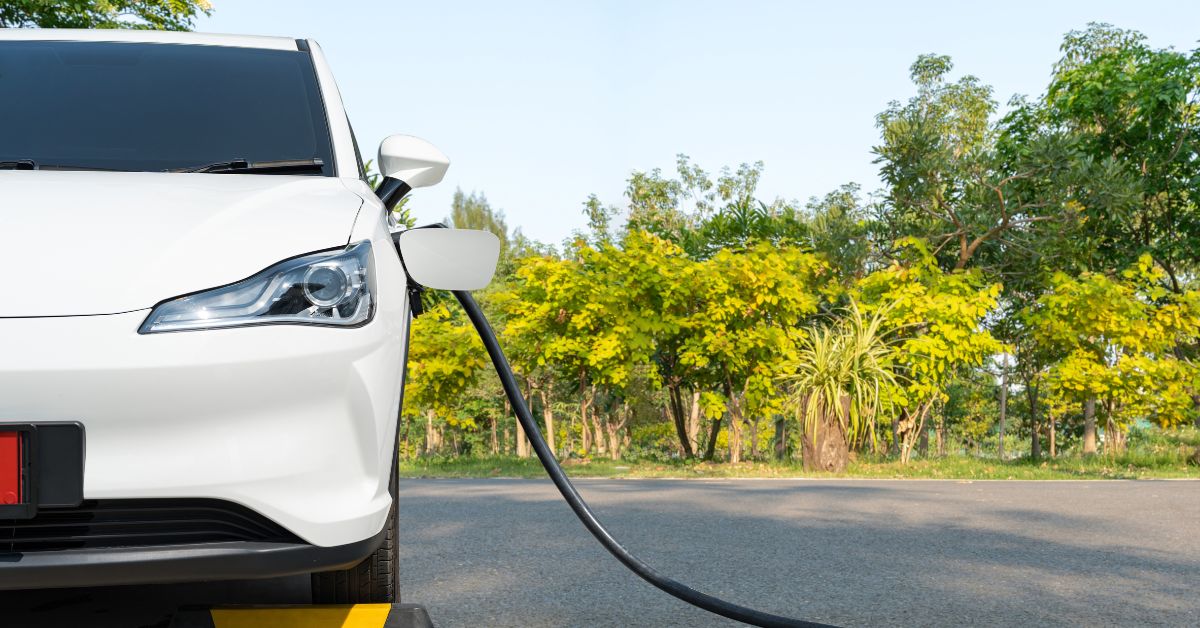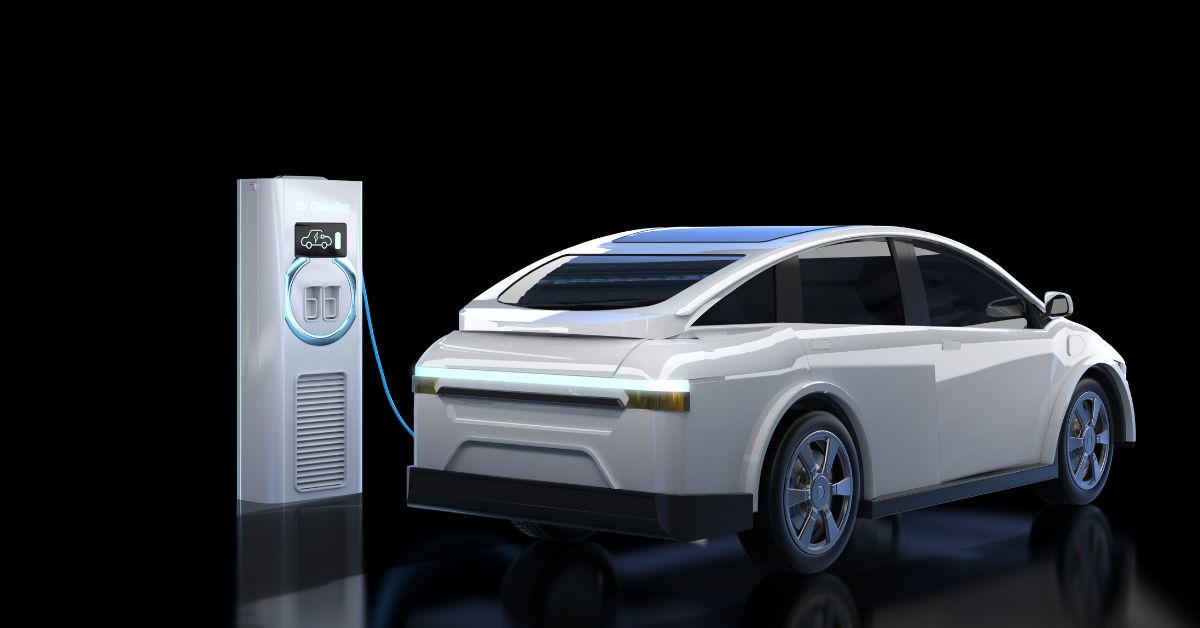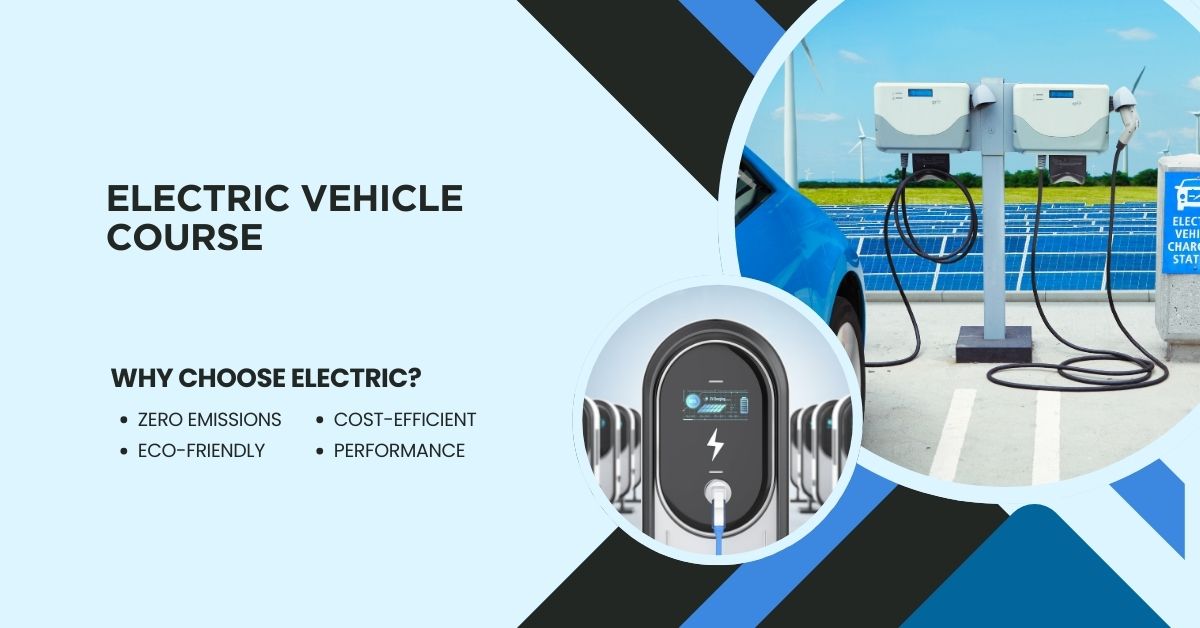Electric Vehicle Course
An Electric Vehicle course provides comprehensive knowledge of the design, operation, and technology behind electric vehicles. It covers battery systems, charging infrastructure, motor control, and sustainable transportation solutions. Ideal for enthusiasts, engineers, and professionals, the course equips learners with skills to contribute to the growing EV industry.
Electric Vehicle Course
Table of Contents:
- Introduction to Electric Vehicles
- Definition and Overview
- Historical Background
- Importance of EVs in Today’s World
- Types of Electric Vehicles
- Battery Electric Vehicles (BEVs)
- Plug-in Hybrid Electric Vehicles (PHEVs)
- Hybrid Electric Vehicles (HEVs)
- Fuel Cell Electric Vehicles (FCEVs)
- Key Components of Electric Vehicles
- Electric Motors
- Battery Systems
- Charging Infrastructure
- Power Electronics and Controllers
- How Electric Vehicles Work
- Energy Conversion Process
- Regenerative Braking Systems
- Differences Between EVs and Traditional Combustion Engines
- Battery Technologies for EVs
- Lithium-ion Batteries
- Solid-State Batteries
- Battery Management Systems
- Future Trends in EV Battery Technology
- Charging Electric Vehicles
- Types of Charging (Level 1, 2, and DC Fast Charging)
- Charging Stations and Networks
- Home vs Public Charging
- Wireless and Solar-Powered Charging
- Environmental Impact of Electric Vehicles
- Reduction in Greenhouse Gas Emissions
- Challenges: Battery Disposal and Recycling
- Economics of Electric Vehicles
- Total Cost of Ownership
- Government Incentives
- Resale Value
- Global Market Trends and Adoption
- Challenges Facing Electric Vehicles
- The Future of Electric Vehicles
Introduction to Electric Vehicles
Definition and Overview
Electric vehicles (EVs) are automobiles powered by electricity rather than traditional fossil fuels like gasoline or diesel. Unlike conventional cars, which rely on internal combustion engines (ICEs), EVs use electric motors and batteries to propel the vehicle. This transition towards electrification is seen as a key solution to reducing greenhouse gas emissions and combatting climate change.
Historical Background
The concept of electric vehicles is not new. The first electric vehicle was built in the 19th century. However, due to the discovery and mass production of gasoline-powered vehicles, electric cars faded into the background. It wasn’t until the late 20th century, when environmental concerns began to surface, that interest in EVs re-emerged. The introduction of mass-market electric cars, like the Tesla Model S and Nissan Leaf, marked a turning point in the automotive industry.
Importance of EVs in Today’s World
Today, EVs are becoming a central part of global transportation systems due to their ability to reduce air pollution and dependence on fossil fuels. They also offer the potential for energy independence, as the electricity used to power EVs can come from renewable sources like solar and wind.
Types of Electric Vehicles
Battery Electric Vehicles (BEVs)
They do not have a gasoline engine, and the energy is stored in large battery packs. BEVs are known for their zero emissions and smooth driving experience. Popular models include the Tesla Model 3, Nissan Leaf, and Chevrolet Bolt.

Plug-in Hybrid Electric Vehicles (PHEVs)
PHEVs combine both an electric motor and a traditional internal combustion engine. They can operate on electric power alone for short distances, after which the gasoline engine kicks in. This offers flexibility for drivers who want the environmental benefits of electric driving but need a backup for longer trips. The Toyota Prius Prime is a well-known PHEV.
Hybrid Electric Vehicles (HEVs)
Unlike PHEVs, hybrid electric vehicles cannot be plugged in to charge. Instead, they generate electricity through regenerative braking and by using the internal combustion engine. HEVs primarily use gasoline power but switch to electric power in certain driving conditions, such as when idling or cruising. The Toyota Prius is a leading HEV model.
Fuel Cell Electric Vehicles (FCEVs)
While not as common as BEVs or PHEVs, FCEVs offer a potential solution for long-range, zero-emission driving, with the only byproduct being water vapor.
Key Components of Electric Vehicles
Electric Motors
The electric motor is the heart of the EV, converting electrical energy stored in the battery into mechanical energy to move the vehicle. Unlike combustion engines, electric motors have fewer moving parts, which makes them more efficient and easier to maintain.
Battery Systems
The battery pack stores the energy required to power the electric motor. Most modern EVs use lithium-ion batteries due to their high energy density and long lifespan. The capacity of the battery pack determines the range of the vehicle, which is a key concern for many potential EV buyers.
Charging Infrastructure
Charging infrastructure refers to the network of charging stations where EV owners can recharge their vehicles. This includes both public charging stations and private home chargers. The availability of charging infrastructure is critical to the widespread adoption of EVs.
Power Electronics and Controllers
Power electronics control the flow of electricity from the battery to the motor and other components of the EV. These systems play a vital role in ensuring the vehicle operates efficiently and safely.
How Electric Vehicles Work
Electric vehicles operate by converting stored electrical energy into mechanical energy to propel the vehicle. The electric motor, which replaces the traditional engine, receives energy from the battery system and turns the vehicle’s wheels. Unlike internal combustion engines, which rely on fuel combustion to generate power, electric motors produce immediate torque, resulting in faster acceleration.
Energy Conversion Process
Electric vehicles use a process called energy conversion, where electrical energy from the battery is turned into mechanical energy by the electric motor. When the accelerator is pressed, the motor pulls electricity from the battery and uses magnetic fields to turn the wheels.
Regenerative Braking Systems
This technology allows the electric motor to act as a generator during braking, converting kinetic energy back into electrical energy and storing it in the battery. This not only increases efficiency but also extends the vehicle’s range.
Differences Between EVs and Traditional Combustion Engines
The most significant difference between EVs and traditional vehicles is how they generate power. While internal combustion engines rely on burning fuel, EVs rely on stored electricity. Additionally, EVs tend to have fewer moving parts, which reduces maintenance costs. They are also quieter and produce no tailpipe emissions.
Battery Technologies for EVs
Lithium-ion Batteries
Lithium-ion batteries are the most commonly used battery type in electric vehicles due to their high energy density and relatively low weight. These batteries are efficient, have a long lifespan, and can be recharged hundreds of times.
Solid-State Batteries
Solid-state batteries are a newer technology that many believe will revolutionize the EV market. They use solid electrolytes instead of liquid ones, which makes them safer and more energy-dense. However, solid-state batteries are still in the development phase and are expected to become commercially viable in the coming years.
Battery Management Systems
Battery management systems (BMS) monitor and regulate the battery pack, ensuring optimal performance and safety. A BMS helps prevent overcharging, overheating, and deep discharges, which can damage the battery and reduce its lifespan.
Future Trends in EV Battery Technology
The future of EV batteries is bright, with ongoing research into higher capacity, faster charging, and more environmentally friendly technologies. Innovations like solid-state batteries, graphene batteries, and improved recycling processes are expected to transform the industry in the coming decades.
Charging Electric Vehicles
Types of Charging (Level 1, 2, and DC Fast Charging)
Electric vehicles can be charged using three main types of charging: Level 1 (home charging using a standard wall outlet), Level 2 (faster home charging or public chargers), and DC Fast Charging (rapid charging available at select public stations). Each level offers varying charging speeds, with DC Fast Charging being the quickest option.
Charging Stations and Networks
Public charging stations are expanding worldwide, supported by various networks such as Tesla’s Supercharger network, ChargePoint, and Electrify America. These networks provide access to charging stations in urban areas, highways, and shopping centers, making long-distance EV travel easier.
Home vs Public Charging
Many EV owners prefer to charge their vehicles at home, typically overnight, using a Level 1 or Level 2 charger. However, for long trips or if home charging is unavailable, public charging stations provide a convenient alternative.
Wireless and Solar-Powered Charging
Future advancements include wireless charging pads, which allow EVs to charge simply by parking over a charging surface. Solar-powered charging stations are also gaining traction, offering clean energy solutions for EVs.
Environmental Impact of Electric Vehicles
The rise of electric vehicles (EVs) is often lauded as a critical step in reducing our dependence on fossil fuels and combating climate change. As transportation accounts for a significant portion of global greenhouse gas emissions, the shift from internal combustion engine (ICE) vehicles to electric power has the potential to transform the environmental landscape. However, it is important to examine not just the advantages, but also the challenges that come with EV adoption.

Reduction in Greenhouse Gas Emissions
One of the primary benefits of EVs is their potential to significantly reduce greenhouse gas (GHG) emissions, contributing to global warming and climate change. In traditional internal combustion engine vehicles, fuel combustion releases carbon dioxide (CO₂), methane (CH₄), and nitrous oxide (N₂O) into the atmosphere. EVs, on the other hand, have no tailpipe emissions, meaning they do not directly release harmful pollutants into the air during operation.
Challenges: Battery Disposal and Recycling
As the number of electric vehicles on the road increases, so does the need to address the disposal and recycling of EV batteries. Improper disposal of lithium-ion batteries can lead to environmental hazards, as they contain toxic chemicals that can leak into the ground and water systems. Additionally, the extraction of materials like lithium and cobalt for new batteries continues to pose environmental and ethical challenges.
Current Recycling Practices
At present, the recycling of EV batteries is still in its infancy. Only a small percentage of lithium-ion batteries are currently recycled, largely due to the complexity and cost of the recycling process. However, as EV adoption grows, more investment is being directed toward improving battery recycling technologies. Companies and researchers are developing methods to recover valuable materials from old batteries, reducing the need for new mining operations and lowering the overall environmental impact of battery production.
Second-Life Batteries
In addition to recycling, there are emerging solutions to extend the life of EV batteries. Once a battery’s performance declines below a certain vehicle-use threshold, it can still be repurposed for other applications, such as stationary energy storage. These “second-life” batteries can store energy from renewable sources like solar and wind, providing grid stability and reducing reliance on fossil fuels.
Economics of Electric Vehicles
The shift toward electric vehicles (EVs) is driven not only by environmental concerns but also by evolving economic factors. Understanding the economics of electric vehicles is crucial for individuals, businesses, and governments as they make decisions regarding their transportation needs and policies.
Total Cost of Ownership (TCO)
When considering the total cost of ownership, which includes purchase price, fuel costs, maintenance, and resale value, EVs often come out ahead of ICE vehicles. A study by Consumer Reports found that EVs could save owners between $6,000 and $10,000 over the life of the vehicle compared to a gas-powered car.
Government Incentives
Governments around the world are providing various incentives to promote EV adoption, including:
- Tax Credits and Rebates: EV buyers often receive tax credits or rebates to lower the effective purchase price.
- Reduced Registration Fees: Some regions offer reduced registration fees for EV owners.
- Access to HOV Lanes: In certain areas, EVs are allowed to use high-occupancy vehicle (HOV) lanes, which saves time and improves overall convenience for owners.
Resale Value
Historically, EVs have had lower resale values compared to their ICE counterparts. However, this is changing as the demand for EVs grows and technology improves. In addition, policies that limit the sale of ICE vehicles in the future may increase the desirability and resale value of used EVs.
Global Market Trends and Adoption
Global Growth of EV Sales
- Rapid Sales Growth: The global electric vehicle market has seen exponential growth in recent years. EV sales surpassed 10 million units in 2023, a significant jump from previous years.
- Leading Markets: China, Europe, and the United States are the largest EV markets, with China being the global leader, accounting for more than 50% of total EV sales.
- Emerging Markets: Countries in Southeast Asia, Latin America, and Africa are beginning to show increased adoption, though infrastructure and affordability remain challenges.
Government Policies and Incentives
- Policy Support: Government policies, such as subsidies, tax benefits, and incentives for EV manufacturers and consumers, have been key drivers of market growth. Europe’s Green Deal and the U.S.’s Inflation Reduction Act are examples of such initiatives.
- Emission Regulations: Stricter emission regulations are prompting car manufacturers to invest heavily in EV technologies to meet environmental targets.
Technological Advancements
- Battery Innovation: Advancements in battery technology, such as solid-state batteries and improved lithium-ion batteries, are reducing costs and increasing the range and efficiency of EVs.
- Charging Infrastructure: Expanding charging infrastructure globally, especially in urban areas, has helped alleviate “range anxiety” and contributed to higher adoption rates.
Cost Parity with Internal Combustion Engines (ICE)
- Falling EV Prices: The cost of electric vehicles is steadily decreasing, and by 2027, EVs are expected to reach price parity with ICE vehicles due to declining battery costs and economies of scale.
- Long-term Savings: Consumers are becoming more aware of the long-term savings from EVs, including lower maintenance costs and cheaper fueling through electricity.
Corporate Commitments
- Automaker Transition: Major automakers like Tesla, General Motors, Volkswagen, and BYD are significantly expanding their EV portfolios. Many have committed to phasing out gasoline vehicles by 2030 or 2035.
- Fleet Electrification: Companies are also electrifying their fleets, contributing to increased EV demand. Amazon and UPS, for instance, are investing in electric delivery vehicles.
Regional Differences in Adoption
- China: Leading the world in EV adoption, with aggressive manufacturing and sales targets. Government subsidies, local production, and infrastructure development are pivotal.
- Europe: Strong EV sales, supported by stringent emissions regulations and government incentives. Norway is a standout, where EVs accounted for nearly 80% of new car sales in 2023.
- United States: EV adoption is accelerating, particularly with Tesla dominating the market. New policies, including tax credits for EV buyers, are expected to further boost sales.
Challenges in Global Adoption
- Infrastructure Gaps: In many countries, especially in developing regions, the lack of charging infrastructure remains a major barrier.
- Supply Chain Constraints: The availability of raw materials for battery production, such as lithium and cobalt, could slow down the pace of EV adoption.
- Consumer Education: Misinformation and limited awareness of the benefits of EVs still hinder market growth in certain areas.
Future Outlook
- Increased Market Penetration: By 2030, EVs are projected to account for more than 30% of new car sales globally, driven by technological advancements, cost reductions, and supportive policies.
- Sustainability Focus: The global shift toward sustainable transportation will further push EV adoption, especially as renewable energy integration into the charging infrastructure grows.
This framework should give you a solid foundation for exploring global market trends and adoption in your blog post. Let me know if you’d like to expand on any section!
Challenges Facing Electric Vehicles
The electric vehicle (EV) industry faces a variety of challenges that could slow down its widespread adoption. These include:

Battery Technology and Cost
- High Battery Cost: Despite advances, EV batteries are still expensive, contributing to the higher upfront cost of electric vehicles compared to conventional petrol or diesel vehicles.
- Battery Life and Performance: Current battery technologies have limitations in terms of range, lifespan, and charging times. This affects consumer confidence in EVs for long-distance travel.
- Resource Dependency: The production of EV batteries relies on rare materials like lithium, cobalt, and nickel. These resources are concentrated in a few countries, creating supply chain vulnerabilities.
Charging Infrastructure
- Lack of Charging Stations: One of the most significant barriers is the inadequate charging infrastructure, particularly in rural and suburban areas. Consumers need access to convenient and fast-charging networks.
- Charging Speed: Fast-charging technology is still being developed and scaled, and the time it takes to charge an EV is significantly longer than refueling a petrol or diesel vehicle.
Range Anxiety
- Limited Range: Although EV ranges are improving, many consumers still worry about running out of power on long trips, especially when charging stations are sparse.
Supply Chain and Manufacturing
- Production Capacity: Many EV manufacturers are facing supply chain bottlenecks for essential components like semiconductors, batteries, and electric motors, limiting their ability to meet demand.
- Scaling Manufacturing: As demand grows, EV manufacturers need to scale up production without compromising on quality, efficiency, or environmental impact.
Environmental Concerns
- Battery Disposal: While EVs produce zero tailpipe emissions, the environmental impact of mining materials for batteries and disposing of them at the end of their lifecycle poses sustainability concerns.
- Energy Source: The effectiveness of EVs in reducing emissions depends on the energy source used for charging. In regions where electricity is generated from coal or other fossil fuels, EVs may not significantly reduce carbon emissions.
Government Policies and Support
- Inconsistent Policies: Government incentives and regulations supporting EVs vary greatly by region, creating uncertainties for manufacturers and consumers.
- Subsidy Phase-Out: In some regions, government subsidies for EVs are being phased out, which could make them less attractive to consumers due to higher purchase costs.
Consumer Awareness and Perception
- Lack of Awareness: Many consumers are still unaware of the long-term benefits and cost savings of electric vehicles.
- Resistance to Change: Some consumers are hesitant to switch from internal combustion engine vehicles due to brand loyalty, range anxiety, or misconceptions about EV performance.
Market Competition
- Traditional Automakers: Established automakers are investing heavily in EV technology, but competition from newcomers and startups is fierce. This competition could either push innovation forward or lead to market fragmentation.
Addressing these challenges requires continued innovation, investment in infrastructure, and supportive government policies to drive EV adoption forward.
The Future of Electric Vehicles
The electric vehicle (EV) industry is on the verge of a significant transformation, driven by technological advancements, government policies, and consumer demand for sustainable solutions. The future of electric vehicles looks promising as they continue to evolve, offering numerous benefits and reshaping the automotive landscape. Here are some key trends and factors that will shape the future of EVs:
Technological Advancements
- Battery Technology: Innovations in battery technology will be a game changer. The development of solid-state batteries, which offer higher energy density, faster charging times, and increased safety, is one area of focus. Breakthroughs in lithium-ion battery efficiency and alternative battery materials like lithium-sulfur and graphene will further enhance EV performance.
- Autonomous Driving: EVs are at the forefront of autonomous vehicle technology. Self-driving features are expected to become more advanced, making electric vehicles not only environmentally friendly but also smarter and safer.
- Wireless Charging: As the demand for convenience grows, wireless charging technology for EVs will likely become mainstream. Charging stations embedded in roads or parking lots will allow vehicles to charge without the need for plugs.
Government Support
- Incentives and Regulations: Governments worldwide are implementing strict emission regulations and offering incentives like tax breaks, subsidies, and grants to accelerate the adoption of EVs. This trend is expected to continue, particularly in countries that aim to achieve carbon neutrality in the coming decades.
- Investment in Infrastructure: A key factor for the widespread adoption of EVs is the expansion of charging infrastructure. Governments and private companies are investing heavily in building fast-charging networks, making long-distance EV travel more feasible and convenient.
Sustainability and Environmental Impact
- Reduction of Carbon Emissions: As global concerns about climate change grow, the shift to electric vehicles is seen as a critical step toward reducing greenhouse gas emissions. EVs produce zero tailpipe emissions, and as renewable energy becomes a larger part of the electricity grid, their overall environmental impact will decrease even further.
- Recycling and Second-Life Applications: The future of EVs will also focus on the sustainability of battery materials. Companies are working on efficient recycling methods and repurposing used EV batteries for energy storage in homes and businesses.
Affordability and Mass Adoption
- Cost Reduction: The cost of EVs is expected to decrease significantly as production scales up and battery costs drop. Many analysts predict that EVs will reach price parity with internal combustion engine (ICE) vehicles within the next decade, making them more accessible to a broader range of consumers.
- Expansion of EV Models: Automakers are introducing a wide variety of EV models, ranging from affordable compact cars to luxury sedans and electric trucks. This diversification will cater to different consumer preferences and needs, driving further adoption.
Impact on the Automotive Industry
- Shifting Business Models: Automakers are rethinking their business strategies, with many transitioning from traditional manufacturing to offering services like vehicle subscriptions, ride-sharing, and fleet management—all centered around electric vehicles.
- New Players in the Market: Alongside established automakers, new players, especially startups focused on electric and autonomous vehicles, are entering the market. These companies are likely to drive innovation and competition, further pushing the boundaries of EV technology.
Energy Integration
- Vehicle-to-Grid (V2G) Technology: The integration of EVs into the energy grid will be a crucial development. V2G technology allows electric vehicles to not only draw energy from the grid but also send energy back, providing support to the grid during peak demand periods. This two-way interaction could turn EVs into mobile energy storage units, helping stabilize the power supply and encouraging the use of renewable energy.
Challenges and Opportunities
- Charging Infrastructure: While charging networks are expanding, more work is needed to ensure that rural and less-developed regions have access to reliable charging stations.
- Supply Chain and Material Sourcing: The supply chain for key materials like lithium, cobalt, and nickel must be improved to avoid bottlenecks. Ethical sourcing of materials, particularly concerning labor practices, will become a more prominent issue.
- Consumer Behavior: Some consumers remain hesitant to switch to EVs due to concerns over range, charging time, and vehicle cost. Overcoming these psychological barriers will be essential for mass adoption.
Click here to learn more about Electric Vehicle Course
Click here to learn more about Electric Vehicle Charging Stations Near Me
